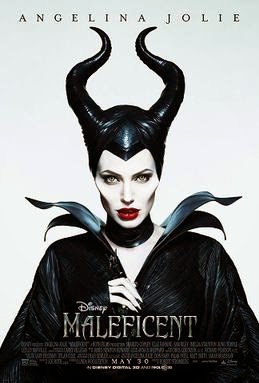And I won’t do the usual plot summary bit here because the plot of the film is essentially a “sympathy for the devil” take on Disney’s 1959 animated Sleeping Beauty, starring Angelina Jolie as the eponymous fairy queen who’s betrayed by the kingdom of men before she curses the young princess Aurora (Elle Fanning). While this sounds like a prime opportunity to reinvent the story, promising us the version of the fairy tale we hadn’t heard before, Maleficent very much amounts to a pulled punch.
I’ll start with the good news, and it’s probably something you’ve already heard because nearly every film critic agrees: Jolie is perfectly cast as Maleficent; she does a phenomenal job delighting in her own wickedness, she walks with the grace of a fairy queen, and her delivery captures flawlessly the intonations Eleanor Audley brought to the original. And there’s a curious moment near the middle of the film where Maleficent restages the curse scene from the original Sleeping Beauty animated film. I say curious because it is unequivocally one of the best moments in the entire film, and it leads me to wonder why Disney bothered with all the trappings of a retelling and didn’t just opt for a straight remake.
I hate to be cynical, but frankly this film is aimed at the grungy Hot Topic crowd, who are probably going to love it. Maleficent is part of Disney’s recent push to reinvent classic films, as with Tim Burton’s Alice in Wonderland and the upcoming Kenneth Branagh Cinderella (March 2015), but it’s not as successful as Wonderland was because it never commits to a core idea – or rather, it commits to too many. Angelina Jolie is so good that her character deserves a better vehicle, one more certain of what it wanted to do with the character. Either Disney should have given us the true between-the-scenes take on what Maleficent was up to, or it should have given us a truly sympathetic portrait of Maleficent the misunderstood. Instead, the film tries to give us both, and the result is a film that never fully invests to itself.
It’s a cop-out to boot – either you want us to sympathize with the character or you don’t (or, if you’re Breaking Bad, spend six years exploring that gray area). The film’s conclusion that Maleficent was both a hero and a villain is, truthfully, an evasion. You do see the hand of uncredited rewriter Paul Dini here; he famously brought pathos to the backstories of many Batman villains in the early 1990s animated series, though the fact that only Linda Woolverton gets screenwriting credit suggests why Disney’s Maleficent can’t do in 97 minutes what Batman’s “Heart of Ice” did in 20. (I’m referring, of course, to the definitive rebranding of Mr. Freeze as a tragic villain out to avenge his cryo-frozen wife.)
Honestly, I’m not sure if the bigger problem with the film is a studio that wants to have its fairy cake and eat it too, or if first-time director Robert Stromberg is juggling too much at once. The film does have a very appealing look, and the shots are very interesting. The special effects look good, especially the climactic dragon battle. Interestingly, the film also participates in Disney’s recent trend of rejecting “love at first sight” and backing away from “love conquers all.” With Frozen and Brave, Maleficent makes three films where the studio offers a self-reflexive critique of its early, easier boy-meets-girl narratives. The difference is, however, that by now we’ve already seen this new spin, and the film doesn’t really break any new ground on that front.
Maybe I’m just being excessively vitriolic because I haven’t written a truly bad review in a while, and the bile’s built up. I will say that I’m not sorry to have seen it. I’m a fantastic Disney shill and will watch just about anything the studio puts out, and although it may not sound like it I truly do not begrudge Maleficent the ninety-plus minutes I spent watching it. It’s fine for what it is, but it’s impossible to watch the movie and not see snippets of a much grander, more ambitious project. But, as the film states explicitly, ambition is supposed to be bad, and so the result is a somewhat neutered update on a fairy tale which, this very update proves, didn’t need updating in the first place – at least, not the kind of halfhearted updating we’ve been given.
Maleficent is rated PG for “sequences of fantasy action and violence, including frightening images.” The scene after Maleficent’s wings are taken is disturbing – many are reading it as a rape metaphor – and some blood is seen on her back. As for frightening images, there’s nothing scarier than what a conventional Disney film offers; there is some swordfighting, and iron is seen to burn fairies in a few scenes.


1 comment:
Agreed, they really didn't do much with the material. And I didn't even think Jolie was that good. She looked the part, but was never very compelling, either as a villain you love to hate or a protagonist you can get behind.
Post a Comment